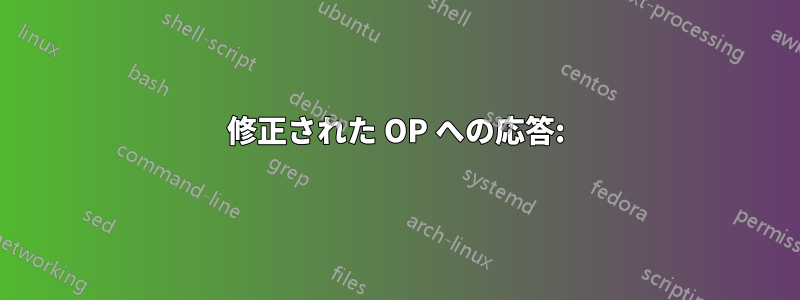
私は次のような(Photoshopで加工した)レンダリングを描きたいと思っています。
この画像は3つの で構成されており\node、それぞれが異なる境界線を使用しています。全体を に固定しているのはchain、私が実際に作成しているのが次のようなものだからです。TikZチュートリアルの構文図(p60)。
現在、L、C、R 間の境界もレンダリングする MWE があります\nodeが、外側の境界を変更せずにそれらの境界を消すようにしたいと考えています。
実際のコード:

\documentclass{standalone}
\usepackage{tikz}
\usetikzlibrary{chains,scopes,shapes.misc}
\begin{document}
\begin{tikzpicture}[start chain,
node distance=5mm,
every node/.style={on chain},
connect/.style={join=by ->},
point/.style={coordinate},
l/.style={draw, fill=cyan!50, rounded rectangle, rounded rectangle right arc=0},
c/.style={draw, fill=green!50},
r/.style={draw, fill=orange!50, rounded rectangle, rounded rectangle left arc=0},
cozy/.style={node distance=-\pgflinewidth}]
\node[point] (p1) {};
\node [l, connect] (l) {L};
{[cozy]
\node [c] (c) {C};
\node [r] (r) {R};
}
\node[point, connect] (p2) {};
\end{tikzpicture}
\end{document}
カスタムボーダー(改訂版)
私はフォローしましたこの例、@ハリシュ・クマールの答え、 そしてこの答え図形の各セクションごとに少しずつ異なるアプローチを使用して、手動で境界線を描画してみました。すべてに欠点があります。
- Lに適用:
\nodeをline widthデフォルト (\pgflinewidth)のままにしておくと、 の周囲に幅 のスペースがdraw=noneできます。 の寸法内に境界線を描画するには、境界線がこのスペースを超えて伸びないようにする必要があります。残念ながら、境界線の内側の一部がフィラーの背後に描画され、境界線が細すぎるように見えます。さらに、東側のアンカー ポイントが少しずれているように見えます。\node0.5*\pgflinewidth\node - C に適用:
\node'sを設定するとline width=0、少なくともすべてのアンカー ポイント (特に東部と西部) が正しい位置にあることが保証されます。ただし、この方法では、境界線全体がフィラーの背後に描画されます。 - Rに適用:
\nodeを設定しline width=0、境界線を描く外フィラーの。これにより、境界線が\nodeの寸法の外側になり、接続オブジェクトと重なることになります。

\documentclass{standalone}
\usepackage{tikz}
\usetikzlibrary{calc,chains,scopes,shapes.misc,backgrounds}
\pgfdeclarelayer{background}
\pgfdeclarelayer{foreground}
\pgfdeclarelayer{foreforeground}
\pgfsetlayers{background,main,foreground,foreforeground}
\begin{document}
\begin{tikzpicture}[start chain,
node distance=5mm,
every node/.style={on chain},
connect/.style={join=by ->},
point/.style={coordinate},
l/.style={line width=\pgflinewidth, fill=cyan!50, rounded rectangle, rounded rectangle right arc=0, append after command={% <= for the border
\pgfextra{\begin{pgfinterruptpath}\begin{pgfonlayer}{foreground}
\draw[] let \p1=($(\tikzlastnode.north east)+(-0.5\pgflinewidth,-0.5\pgflinewidth)$),
\p2=($(\tikzlastnode.north west)+(0,-0.5\pgflinewidth)$),
\p3=($(\tikzlastnode.south west)+(0,0.5\pgflinewidth)$),
\p4=($(\tikzlastnode.south east)+(-0.5\pgflinewidth,0.5\pgflinewidth)$),
\n1={0.5*(\y2-\y3)} in
(\p1) -- (\p2) arc(90:270:\n1) -- (\p4);
\end{pgfonlayer}\end{pgfinterruptpath}}
}},
c/.style={line width=0, fill=green!50, append after command={% <= for the border
\pgfextra{%
\begin{pgfinterruptpath}\begin{pgfonlayer}{foreground}
\draw[] let \p1=($(\tikzlastnode.north east)+(0,-0.5\pgflinewidth)$),
\p2=($(\tikzlastnode.north west)+(0,-0.5\pgflinewidth)$),
\p3=($(\tikzlastnode.south west)+(0,0.5\pgflinewidth)$),
\p4=($(\tikzlastnode.south east)+(0,0.5\pgflinewidth)$) in
(\p1) -- (\p2) (\p3) -- (\p4);
\end{pgfonlayer}\end{pgfinterruptpath}
}
}},
r/.style={line width=0, fill=orange!50, rounded rectangle, rounded rectangle left arc=0, append after command={% <= for the border
\pgfextra{%
\begin{pgfinterruptpath}
\draw[] let \p1=($(\tikzlastnode.north east)+(0,0.5\pgflinewidth)$),
\p2=($(\tikzlastnode.north west)+(0,0.5\pgflinewidth)$),
\p3=($(\tikzlastnode.south west)+(0,-0.5\pgflinewidth)$),
\p4=($(\tikzlastnode.south east)+(0,-0.5\pgflinewidth)$),
\n1={0.5*(\y1-\y4)} in
(\p3) -- (\p4) arc(-90:90:\n1) -- (\p2);
\end{pgfinterruptpath}
}
}}
]
\node[point] (p1) {};
\node [l, connect] (l) {L};
{[node distance=-0.5\pgflinewidth]
\node [c] (c) {C};}
{[node distance=0]
\node [r] (r) {R};}
\node[point, connect] (p2) {};
\node[font=\tiny, cyan, below=of l] (lbl l-se) {l.se};
\draw[red,->] (lbl l-se) -- (l.south east);
\begin{pgfonlayer}{foreforeground}%apparently, using layer 'foreground' in 'append after command' brings the entire node to the front, which we don't want!
\node[font=\tiny, green, below=of c, yshift=2mm] (lbl c-ne) {c.ne};
\draw[red,->] (lbl c-ne) -- (c.north east);
\end{pgfonlayer}
\node[font=\tiny, orange, below=of r] (lbl r-sw) {r.sw};
\draw[red,->] (lbl r-sw) -- (r.south west);
\end{tikzpicture}
\end{document}
カスタム枠線が\nodeの枠線内に収まるようにするにはどうすればいいでしょうか?上にの\nodeフィラーカラーは?\begin{pgfonlayer}{foreground}境界線を最前面に表示するために を 使用しようとしましたが、境界線がフィラーの背後にあるまま、append after command全体が最前面に表示されるだけのようです。\node
答え1
以下の方法で減らしたり増やしたりできます0.5\pgflinewidth:
\documentclass[border=10pt]{standalone}
\usepackage{tikz}
\usetikzlibrary{calc,chains,scopes,shapes.misc,calc}
\begin{document}
\begin{tikzpicture}[start chain,
node distance=5mm,
every node/.style={on chain},
connect/.style={join=by ->},
point/.style={coordinate},
l/.style={fill=cyan!50, rounded rectangle, rounded rectangle right arc=0, append after command={% <= for the border
\pgfextra{%
\begin{pgfinterruptpath}
\draw[] let \p1=(\tikzlastnode.north west), \p2=(\tikzlastnode.south east), \n1={0.5*(\y1-\y2)} in
($(\tikzlastnode.north east)+(-0.5\pgflinewidth,0)$) -- (\tikzlastnode.north west) arc(90:270:\n1) -- ($(\tikzlastnode.south east)+(-0.5\pgflinewidth,0)$);
\end{pgfinterruptpath}
}
}},
c/.style={fill=green!50, append after command={% <= for the border
\pgfextra{%
\begin{pgfinterruptpath}
\draw[] ($(\tikzlastnode.north east)+(-0.5\pgflinewidth,0)$) -- ($(\tikzlastnode.north west)+(0.5\pgflinewidth,0)$) ($(\tikzlastnode.south west)+(0.5\pgflinewidth,0)$) -- ($(\tikzlastnode.south east)+(-0.5\pgflinewidth,0)$);
\end{pgfinterruptpath}
}
}},
r/.style={fill=orange!50, rounded rectangle, rounded rectangle left arc=0, append after command={% <= for the border
\pgfextra{%
\begin{pgfinterruptpath}
\draw[] let \p1=(\tikzlastnode.north west), \p2=(\tikzlastnode.south east), \n1={0.5*(\y1-\y2)} in
($(\tikzlastnode.north west)+(0.5\pgflinewidth,0)$) -- (\tikzlastnode.north east) arc(90:-90:\n1) -- ($(\tikzlastnode.south west)+(0.5\pgflinewidth,0)$);
\end{pgfinterruptpath}
}
}},
cozy/.style={node distance=-\pgflinewidth}]
\node[point] (p1) {};
\node [l, connect] (l) {L};
% introduced space here on purpose, to demonstrate too long borders
\node [c] (c) {C};
{%[cozy]
\node [r] (r) {R};
}
\node[point, connect] (p2) {};
\end{tikzpicture}
\end{document}

修正された OP への応答:
あなたの要件を正しく理解していないかもしれませんが、これがあなたが望んでいるものなのでしょうか?
\documentclass[border=10pt]{standalone}
\usepackage{tikz}
\usetikzlibrary{calc,chains,scopes,shapes.misc,backgrounds}
\pgfdeclarelayer{background}
\pgfdeclarelayer{foreground}
%\pgfdeclarelayer{foreforeground}
\pgfsetlayers{background,main,foreground}%,foreforeground}
\begin{document}
\begin{tikzpicture}[start chain,
node distance=5mm,
every node/.style={on chain},
connect/.style={join=by ->},
point/.style={coordinate},
l/.style={line width=\pgflinewidth, fill=cyan!50, rounded rectangle, rounded rectangle right arc=0, append after command={% <= for the border
\pgfextra{\begin{pgfinterruptpath}\begin{pgfonlayer}{foreground}
\draw[] let \p1=($(\tikzlastnode.north east)+(-0.5\pgflinewidth,-\pgflinewidth)$),
\p2=($(\tikzlastnode.north west)+(0,-\pgflinewidth)$),
\p3=($(\tikzlastnode.south west)+(0,\pgflinewidth)$),
\p4=($(\tikzlastnode.south east)+(-0.5\pgflinewidth,\pgflinewidth)$),
\n1={0.5*(\y2-\y3)} in
(\p1) -- (\p2) arc(90:270:\n1) -- (\p4);
\end{pgfonlayer}\end{pgfinterruptpath}}
}},
c/.style={line width=0, fill=green!50, append after command={% <= for the border
\pgfextra{%
\begin{pgfinterruptpath}\begin{pgfonlayer}{foreground}
\draw[] let \p1=($(\tikzlastnode.north east)+(-0.5\pgflinewidth,-0.5\pgflinewidth)$),
\p2=($(\tikzlastnode.north west)+(0.5\pgflinewidth,-0.5\pgflinewidth)$),
\p3=($(\tikzlastnode.south west)+(0.5\pgflinewidth,0.5\pgflinewidth)$),
\p4=($(\tikzlastnode.south east)+(-0.5\pgflinewidth,0.5\pgflinewidth)$) in
(\p1) -- (\p2) (\p3) -- (\p4);
\end{pgfonlayer}\end{pgfinterruptpath}
}
}},
r/.style={line width=0, fill=orange!50, rounded rectangle, rounded rectangle left arc=0, append after command={% <= for the border
\pgfextra{%
\begin{pgfinterruptpath}
\begin{pgfonlayer}{foreground}
\draw[] let \p1=($(\tikzlastnode.north east)+(0,-0.5\pgflinewidth)$),
\p2=($(\tikzlastnode.north west)+(0,-0.5\pgflinewidth)$),
\p3=($(\tikzlastnode.south west)+(0,0.5\pgflinewidth)$),
\p4=($(\tikzlastnode.south east)+(0,0.5\pgflinewidth)$),
\n1={0.5*(\y1-\y4)} in
(\p3) -- (\p4) arc(-90:90:\n1) -- (\p2);
\end{pgfonlayer}
\end{pgfinterruptpath}
}
}}
]
\node[point] (p1) {};
\node [l, connect] (l) {L};
{[node distance=-0.5\pgflinewidth]
\node [c] (c) {C};}
{[node distance=0]
\node [r] (r) {R};}
\node[point, connect] (p2) {};
%\node[font=\tiny, cyan, below=of l] (lbl l-se) {l.se};
%\draw[red,->] (lbl l-se) -- (l.south east);
%
%\begin{pgfonlayer}{foreforeground}%apparently, using layer 'foreground' in 'append after command' brings the entire node to the front, which we don't want!
%\node[font=\tiny, green, below=of c, yshift=2mm] (lbl c-ne) {c.ne};
%\draw[red,->] (lbl c-ne) -- (c.north east);
%\end{pgfonlayer}
%\node[font=\tiny, orange, below=of r] (lbl r-sw) {r.sw};
%\draw[red,->] (lbl r-sw) -- (r.south west);
\end{tikzpicture}
\end{document}

変更c/.styleする
c/.style={line width=0, fill=green!50, append after command={% <= for the border
\pgfextra{%
\begin{pgfinterruptpath}\begin{pgfonlayer}{foreground}
\draw[] let \p1=($(\tikzlastnode.north east)+(-0\pgflinewidth,-0.5\pgflinewidth)$),
\p2=($(\tikzlastnode.north west)+(0\pgflinewidth,-0.5\pgflinewidth)$),
\p3=($(\tikzlastnode.south west)+(0\pgflinewidth,0.5\pgflinewidth)$),
\p4=($(\tikzlastnode.south east)+(-0\pgflinewidth,0.5\pgflinewidth)$) in
(\p1) -- (\p2) (\p3) -- (\p4);
\end{pgfonlayer}\end{pgfinterruptpath}
}
}},
与える

ただし、これには TikZ 3 が必要です。TikZ 2 は塗りつぶし色の背後に境界線を描画します。
答え2
1 つの可能性としては、ライブラリからマルチパート長方形を使用することですshapes.multipart。
\documentclass{article}
\usepackage{tikz}
\usetikzlibrary{shapes.multipart}
\tikzset{
mynode/.style={
rectangle split,
rectangle split parts=3,
rectangle split horizontal,
draw,
rounded corners=6pt,
rectangle split part fill={cyan!50, green!50,orange!50},
rectangle split draw splits=false
}
}
\begin{document}
\begin{tikzpicture}
\node[mynode] at (2,3) {L\nodepart{two}C\nodepart{three}R};
\end{tikzpicture}
\end{document}



